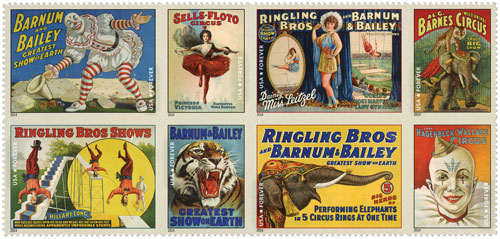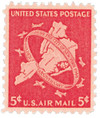
# C38 - 1948 5c New York City Jubilee
U.S. #C38
1948 5¢ New York City Jubilee
Issue Date: July 31, 1948
Printing Method: Rotary press printing
Color: Bright carmine
Confederates Burn Manhattan
On November 25, 1864, a group of Confederate operatives set several fires in New York City, as retaliation for damage done in the South by Union troops.
Though far away from the battlefields and bloodshed, New York City was a hotbed of activity during the Civil War. Early on, the South had hoped it would secede and join them as a city state. In July 1863, the New York Draft Riots claimed 119 lives. Weary soldiers from Gettysburg marched into the city to end the riots. After that, Major General John Dix was given military control of the city.

During the summer and fall of 1861, Confederate operatives made their way to Canada, from where they would launch attacks on the Union. These attacks were planned as retribution for the damage done to the Shenandoah Valley in Virginia. According to one of the conspirators, “our purpose [is] to set the city on fire… and let the government at Washington understand that burning homes in the South might find a counterpart in the North.”

The initial attack was set to take place on election day, November 8. However, word of the plot leaked all the way to Washington, D.C. Secretary of State William Seward sent a telegram to New York’s mayor, warning of the conspiracy. Thousands of Federal troops then marched into the city while gunboats stood at the ready on the surrounding rivers. The attack was postponed, and Union troops left the city on November 15. The conspirators met that same day and renewed plans for the attack 10 days later.

November 25 was a day of special significance to New York City. It had been celebrated as Evacuation Day for more than 80 years – the day the British abandoned the city during the Revolutionary War. That night also marked the first and only time that the three acting brothers Edwin Booth, Junius Booth, Jr., and John Wilkes Booth performed together. (They were appearing in Julius Caesar as a fund raiser to build a bronze statue of William Shakespeare in Central Park.)
In the days leading up the attack, the conspirators entered New York City and checked into hotels under fake names. At least one wore a wig and fake mustache, leading the staff to become suspicious, though they rented him a room anyway. Then, at about 8:45, the first fire was set at the St. James Hotel. A guest saw smoke coming from the room and alerted the staff. They broke down the locked door and put the fire out in a matter of seconds.

Over the next two and a half hours, the Southerners set fire to 19 hotels, a theater, and P.T. Barnum’s American Museum. The museum wasn’t one of the planned targets, but one of the conspirators thought it would “be fun to start a scare.” The fire alarms rang, and firemen were kept busy around town putting out fires. Though the conspirators managed to create a bit of a frenzy, they didn’t cause any significant damage, and luckily, no one was hurt or killed. In fact, they all closed the windows and doors of the rooms they attempted to burn, so none of the fires received enough oxygen to spread. Northerners were outraged at the attempt, nevertheless. City officials expected to have the conspirators in custody in a matter of days. But they all managed to catch trains to Canada before they could be caught. One of the men, Robert Cobb Kennedy, was later apprehended in Detroit and hanged for his crime. He was the last soldier of the war to be executed.
U.S. #C38
1948 5¢ New York City Jubilee
Issue Date: July 31, 1948
Printing Method: Rotary press printing
Color: Bright carmine
Confederates Burn Manhattan
On November 25, 1864, a group of Confederate operatives set several fires in New York City, as retaliation for damage done in the South by Union troops.
Though far away from the battlefields and bloodshed, New York City was a hotbed of activity during the Civil War. Early on, the South had hoped it would secede and join them as a city state. In July 1863, the New York Draft Riots claimed 119 lives. Weary soldiers from Gettysburg marched into the city to end the riots. After that, Major General John Dix was given military control of the city.

During the summer and fall of 1861, Confederate operatives made their way to Canada, from where they would launch attacks on the Union. These attacks were planned as retribution for the damage done to the Shenandoah Valley in Virginia. According to one of the conspirators, “our purpose [is] to set the city on fire… and let the government at Washington understand that burning homes in the South might find a counterpart in the North.”

The initial attack was set to take place on election day, November 8. However, word of the plot leaked all the way to Washington, D.C. Secretary of State William Seward sent a telegram to New York’s mayor, warning of the conspiracy. Thousands of Federal troops then marched into the city while gunboats stood at the ready on the surrounding rivers. The attack was postponed, and Union troops left the city on November 15. The conspirators met that same day and renewed plans for the attack 10 days later.

November 25 was a day of special significance to New York City. It had been celebrated as Evacuation Day for more than 80 years – the day the British abandoned the city during the Revolutionary War. That night also marked the first and only time that the three acting brothers Edwin Booth, Junius Booth, Jr., and John Wilkes Booth performed together. (They were appearing in Julius Caesar as a fund raiser to build a bronze statue of William Shakespeare in Central Park.)
In the days leading up the attack, the conspirators entered New York City and checked into hotels under fake names. At least one wore a wig and fake mustache, leading the staff to become suspicious, though they rented him a room anyway. Then, at about 8:45, the first fire was set at the St. James Hotel. A guest saw smoke coming from the room and alerted the staff. They broke down the locked door and put the fire out in a matter of seconds.

Over the next two and a half hours, the Southerners set fire to 19 hotels, a theater, and P.T. Barnum’s American Museum. The museum wasn’t one of the planned targets, but one of the conspirators thought it would “be fun to start a scare.” The fire alarms rang, and firemen were kept busy around town putting out fires. Though the conspirators managed to create a bit of a frenzy, they didn’t cause any significant damage, and luckily, no one was hurt or killed. In fact, they all closed the windows and doors of the rooms they attempted to burn, so none of the fires received enough oxygen to spread. Northerners were outraged at the attempt, nevertheless. City officials expected to have the conspirators in custody in a matter of days. But they all managed to catch trains to Canada before they could be caught. One of the men, Robert Cobb Kennedy, was later apprehended in Detroit and hanged for his crime. He was the last soldier of the war to be executed.










